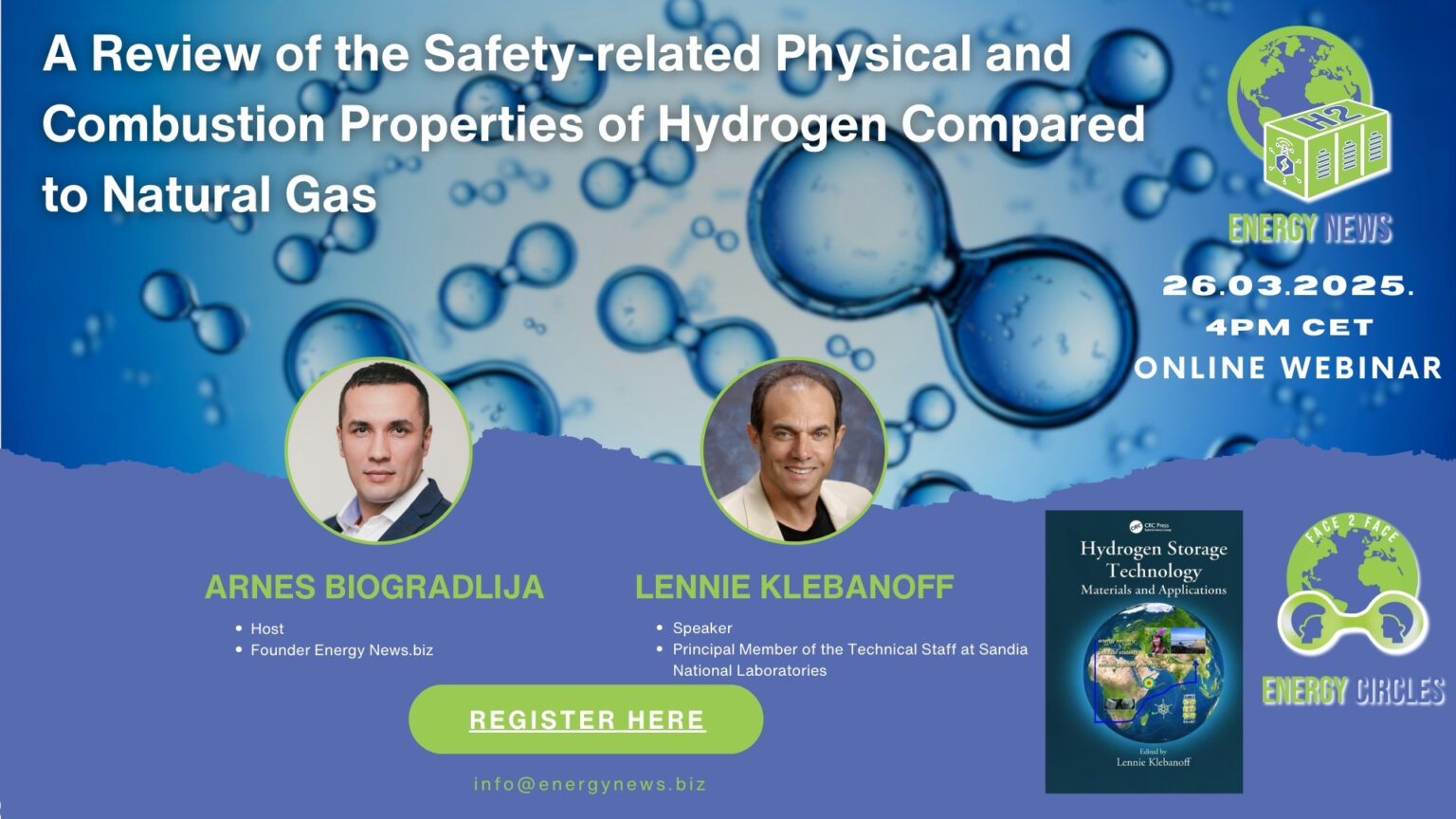A safety presentation by Lennie Klebanoff of Sandia National Laboratories underscores the complexities of handling, storing, and transporting hydrogen safely—issues that demand urgent industry-wide attention.
Hydrogen’s physical properties make it both an attractive energy carrier and a unique safety risk. Its low molecular weight allows for rapid dispersion in open-air environments, reducing the risk of prolonged leaks. However, this same property makes hydrogen prone to escaping through minuscule openings, including metal imperfections in pipelines and storage vessels. Additionally, its broad flammability range (4% to 75% in air) and low ignition energy increase the likelihood of accidental combustion if not managed correctly.
WATCH THE WEBINAR
Beyond technical solutions, Klebanoff emphasizes the role of human factors in hydrogen safety. Mishandling, insufficient training, and lack of awareness about hydrogen’s unique properties can all contribute to accidents. The need for comprehensive safety training programs—particularly as hydrogen scales into new industries—cannot be overstated.
While hydrogen safety challenges are significant, they are not insurmountable. The industry is actively developing safer storage materials, refining detection technologies, and strengthening regulatory frameworks to mitigate risks. However, as hydrogen adoption expands, a proactive approach to safety—rather than reactive adjustments after incidents—will be key to ensuring long-term viability.
Download the presentation below.
Bibliography
Review of the Safety-related Physical and Combustion Properties of Hydrogen Compared to Natural Gas
General H2 and H2 Storage:
L.E. Klebanoff, Editor, “Hydrogen Storage Technology, Materials and Applications” (Taylor and Francis, Boca Raton, 2012) and chapters therein.
Reviews of the Physical and Combustion Properties of Hydrogen:
L.E. Klebanoff, J.W. Pratt and C.B. LaFleur, “Comparison of the Safety-related Physical and Combustion Properties of Liquid Hydrogen and Liquid Natural Gas in the Context of the SF-BREEZE High-Speed Fuel-Cell Ferry,” International Journal of Hydrogen Energy 42 (2017) 757 – 774.
J. Hord, “Is Hydrogen a Safe Fuel,” Int. J. Hydrogen Energy 3 (1978) 157 – 176.
T.D. Donakowski, “Is Liquid Hydrogen Safer than Liquid Methane?” Fire Technology 17 (1981) 183 – 188.
LH2 Spills, Experiments and Modeling:
R.D. Witcofski and J.E. Chirivella, “Experimental and Analytical Analyses of the Mechanisms Governing the Dispersion of Flammable Clouds Formed by Liquid Hydrogen Spills,” Int. J. Hydrogen Energy 9 (1984) 425 – 435.
K. Verfondern and B. Dienhart, “Experimental and Theoretical Investigations of Liquid Hydrogen Pool Spreading and Vaporization,” Int. J. Hydrogen Energy 22 (1997) 649-660.
K. Verfondern and B. Dienhart, “Pool Spreading and Vaporization of Liquid Hydrogen,” Int. J. Hydrogen Energy 32 (2007) 2106 – 2117.
P. Middha, M. Ichard and B. J. Arntzen, “Validation of CFD Modelling of LH2 Spread and Evaporation Against Large-scale Spill Experiments,” Int. J. Hydrogen Energy 36 (2011) 2620-2627.
Hydrogen Fuel Cell Vessels (Ships):
J.W. Pratt and L.E. Klebanoff, “Feasibility of the SF-BREEZE: A Zero-emission, Hydrogen Fuel Cell, High-speed Passenger Ferry,” Sandia Report SAND2016-9719, September 2016.
R.T. Madsen, L.E. Klebanoff, S.A.M. Caughlan, J.W. Pratt, T.S. Leach, T.B. Appelgate Jr., S.Z. Kelety, H.-C. Wintervoll, G.P. Haugom, A.T.Y. Teo and S. Ghosh, “Feasibility of the Zero-V: A Zero-emissions Hydrogen Fuel-cell Coastal Research Vessel,” Int. J. of Hydrogen Energy 45 (2020) 25328-25343.
N. Pal, B. Boudreau, N. Monroe, E. Vaughn, N. Zaag, R. Sookhoo, K. Harris, B. Vogel and L.E. Klebanoff, “Project Nautilus: Introducing a Hydrogen Fuel Cell System as a Retrofit for a Hybrid Electric Vessel,” International Journal of Hydrogen Energy 53 (2024) 1457 – 1476.
L.E. Klebanoff, S.A.M. Caughlan, R.T. Madsen, C.J. Conard, T.S. Leach and T.B. Appelgate, Jr., “Comparative Study of a Hybrid Research Vessel Utilizing Batteries or Hydrogen Fuel Cells,” Int. J. Hydrogen Energy 46 (2021) 38051 – 38072.
“Hydrogen Vessel Feasibility Studies at Sandia National Laboratories,” The Coast Guard Proceedings of the Marine Safety & Security Council, Fall 2022, 46 – 51.
E. Van Sickle, P. Ralli, J.W. Pratt and L.E. Klebanoff “MV Sea Change: The First Commercial 100% Hydrogen Fuel Cell Passenger Ferry in the World,” Int. J. Hydrogen Energy 105 (2025) 389 – 404.
H2 Gas Dispersion and Modeling:
K.M. Gitushi, M.L. Blaylock and L.E. Klebanoff, “Hydrogen Gas Dispersion Studies for Hydrogen Fuel Cell Vessels II: Fuel Cell Room Releases and the Influence of Ventilation,” Int. J. of Hydrogen Energy 47 (2022) 21492 – 21505.
M.L. Blaylock and L.E. Klebanoff, “Hydrogen Gas Dispersion Studies for Hydrogen Fuel Cell Vessels I: Vent Mast Releases,” Int. J. of Hydrogen Energy 47 (2022) 21506 – 21516.
Large Scale H2 and NG Flammability Tests:
A.D. Little, Inc., Report to the U.S. Air Force, C-61092, (1960).
L.H. Cassutt, Report to the U.S. Air Force, Report No. 61-05-5182, (1964).
M. Groethe, E. Merilo, J. Colton, S. Chiba, Y. Sato and H. Iwabuchi, “Large-scale Hydrogen Deflagrations and Detonations,” Int. J. of Hydrogen Energy 32 (2007) 2125 – 2133.
A. Luketa, Sandia National Laboratories Report SAND2011-9415 (2011).
M.P. Sherman, S.R. Tieszen and W.B. Benedick, “FLAME Facility: The Effect of Obstacles and Transverse Venting on Flame Acceleration and Transition to Detonation for Hydrogen-Air Mixtures at Large Scale,” Sandia National Laboratories Report SAND85-1264 R3, 1989.
The Nature of Radiant Heat from LH2 and LNG Pool Fires:
A.D. Little, Inc., “An assessment of the crash fire hazard of liquid hydrogen fueled aircraft.” Final Report to the National Aeronautics and Space Administration, NASACR-165526. 1982.
Hydrogen Permeation and Embrittlement:
D. Sobola and R. Dallaev, “Exploring Hydrogen Embrittlement: Mechanisms, Consequences and Advances in Metal Science,” Energies 17 (2024) 2972.
C. San Marchi, B.P. Somerday and S.L. Robinson, “Permeability, Solubility and Diffusivity of Hydrogen Isotopes in Stainless Steels at High Gas Pressures,” Int. J. of Hydrogen Energy 32 (2007) 100 – 116.
R.P. Gangloff and B.P. Somerday, Editors, “Gaseous Hydrogen Embrittlement of Materials in Energy Technologies,” Vol. 1 and 2, (Woodhead Publishing Ltd., Cambridge, 2012).
Stay updated on the latest in energy! Follow us on LinkedIn, Facebook, and X for real-time news and insights. Don’t miss out on exclusive interviews and webinars—subscribe to our YouTube channel today! Join our community and be part of the conversation shaping the future of energy.





